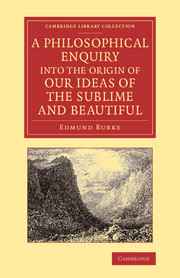Description
A Philosophical Enquiry into the Origin of our Ideas of the Sublime and Beautiful
With an Introductory Discourse Concerning Taste; and Several Other Additions
Cambridge Library Collection - Philosophy Series
Author: Burke Edmund
Published in 1759, this is the second edition of an influential exploration of aesthetic taste by Edmund Burke (1729–97).
Language: English
Subject for A Philosophical Enquiry into the Origin of our Ideas of...:
Approximative price 39.35 €
In Print (Delivery period: 14 days).
Add to cart
Publication date: 01-2014
Support: Print on demand
Support: Print on demand
Description
/li>Contents
/li>
By the eighteenth century, the term 'sublime' was used to communicate a sense of unfathomable and awe-inspiring greatness, whether in nature or thought. The relationship of sublimity to classical definitions of beauty was much debated, but the first philosopher to portray them as opposing forces was Edmund Burke (1729?97). Originally published in 1757 and reissued here in the revised second edition of 1759, this influential treatise explores the psychological origins of both ideas. Presented as distinct consequences of very separate emotional lineages, beauty and sublimity are traced back through a web of human feelings, from self-preservation instincts to lust. Burke's doctrine of the sublime was to have far-reaching effects. In Britain, it informed perceptions of landscape in art and literature for years to come. Meanwhile, on the continent, Kant regarded Burke as 'the foremost author' in 'the empirical exposition of aesthetic judgments'.
Preface; Introduction; Part I: 1. Novelty; 2. Pain and pleasure; 3. The difference between the removal of pain and positive pleasure; 4. Of delight and pleasure; 5. Joy and grief; 6. Of the passions which belong to self-preservation; 7. Of the sublime; 8. Of the passions which belong to society; 9. The final cause of the difference between the passions; 10. Of beauty; 11. Society and solitude; 12. Sympathy, imitation and ambition; 13. Sympathy; 14. The effects of sympathy in the distresses of others; 15. Of the effects of tragedy; 16. Imitation; 17. Ambition; 18. Recapitulation; 19. The conclusion; Part II: 1. Of the passion caused by the sublime; 2. Terror; 3. Obscurity; 4. Of the difference between clearness and obscurity; 5. Power; 6. Privation; 7. Vastness; 8. Infinity; 9. The fame; 10. Succession and uniformity; 11. The effect of uniformity in building; 12. Magnitude in building; 13. Infinity in pleasing objects; 14. Difficulty; 15. Magnificence; 16. Light; 17. Light in building; 18. Colour considered as productive of the sublime; [18.] Sound and loudness; 19. Suddenness; 20. Intermitting; 21. The cries of animals; 23. Smell and taste; 24. Feeling, pain; Part III: 1. Of beauty; 2. Proportion not the cause of beauty in vegetables; 3. Proportion not the cause of beauty in animals; 4. Proportion not the cause of beauty in the human species; 5. Proportion further considered; 6. Fitness not the cause of beauty; 7. The real effects of fitness; 8. The recapitulation; 9. Perfection not the cause of beauty; 10. How far the idea of beauty may be applied; 11. How far the ideas of beauty may be applied to virtue; 12. The real cause of beauty; 13. Beautiful objects small; 14. Smoothness; 15. Gradual variation; 16. Delicacy; 17. Beauty in colour; 18. Recapitulation; 19. The physiognomy; 20. The eye; 21. Ugliness; 22. Grace; 23. Elegance and speciousness; 24. The beautiful in feeling; 25. The beautiful in sounds; 26. Taste and smell; 27. The sublime and beautiful compared; Part IV: 1. Of the efficient cause of the sublime and beautiful; 2. Association; 3. Cause of pain and fear; 4. Continued; 5. How the sublime is produced; 6. How pain can be a cause of delight; 7. Exercise necessary for the finer organs; 8. Why things not dangerous sometimes produce a passion like terror; 9. Why visual subjects of great dimensions are sublime; 10. Unity why requisite to vastness; 11. The artificial infinite; 12. The vibrations must be similar; 13. The effects of succession in visual objects explained; 14. Locke's opinion concerning darkness considered; 15. Darkness terrible in its own nature; 16. Why darkness is terrible; 17. The effects of blackness; 18. The effects of blackness moderated; 19. The physical cause of love; 20. Why smoothness is beautiful; 21. Sweetness, its nature; 22. Sweetness relaxing; 23. Variation, why beautiful; 24. Concerning smallness; 25. Of colour; Part V: 1. Of words; 2. The common effect of poetry; 3. General words before ideas; 4. The effect of words; 5. Examples that words may affect without raising images; 6. Poetry not strictly an imitative art; 7. How words influence the passions.
© 2024 LAVOISIER S.A.S.




